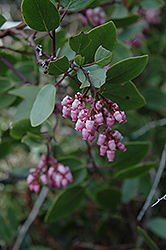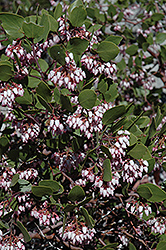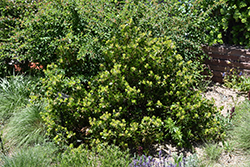Height: 6 feet
Spread: 6 feet
Sunlight:
![]()
![]()
Hardiness Zone: 5
Description:
A handsome densely leafed shrub; very dainty pinkish flowers in spring cover this fine selection; does not like alkaline soils; this is a coastal plant, protect from midday sun when planted inland
Ornamental Features
Greenleaf Manzanita features dainty nodding pink bell-shaped flowers at the ends of the branches from late winter to mid spring. It has forest green evergreen foliage. The glossy oval leaves remain forest green throughout the winter.
Landscape Attributes
Greenleaf Manzanita is a dense multi-stemmed evergreen shrub with an upright spreading habit of growth. Its average texture blends into the landscape, but can be balanced by one or two finer or coarser trees or shrubs for an effective composition.
This is a relatively low maintenance shrub, and should only be pruned after flowering to avoid removing any of the current season's flowers. It has no significant negative characteristics.
Greenleaf Manzanita is recommended for the following landscape applications;
- Accent
- Mass Planting
- Groundcover
- Naturalizing And Woodland Gardens
Planting & Growing
Greenleaf Manzanita will grow to be about 6 feet tall at maturity, with a spread of 6 feet. It tends to fill out right to the ground and therefore doesn't necessarily require facer plants in front, and is suitable for planting under power lines. It grows at a slow rate, and under ideal conditions can be expected to live for approximately 30 years.
This shrub does best in full sun to partial shade. It is very adaptable to both dry and moist growing conditions, but will not tolerate any standing water. It is very fussy about its soil conditions and must have sandy, acidic soils to ensure success, and is subject to chlorosis (yellowing) of the foliage in alkaline soils, and is able to handle environmental salt. It is somewhat tolerant of urban pollution. This species is native to parts of North America.


